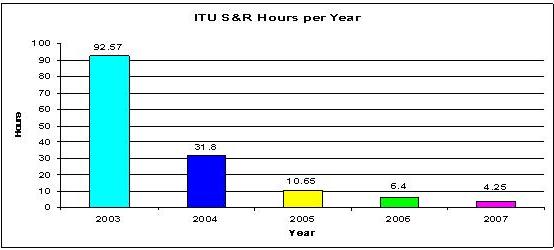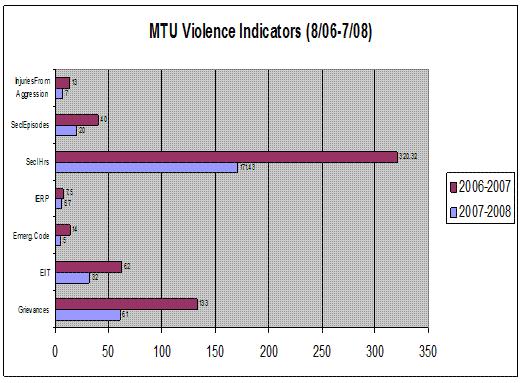Difference between revisions of "Severe Mental Illness and NVC"
m (→Management and Treatment Unit at Mendota Mental Health Institute) |
m (→NVC in an Intensive Treatment Unit) |
||
| Line 1: | Line 1: | ||
| − | ==NVC in an Intensive Treatment Unit == | + | ==NVC in an [http://dhs.wisconsin.gov/mh_mendota/Programs/Forensic/medium.htm#itu Intensive Treatment Unit] == |
| − | [[Image:ITU_SR_hrs_pa_app_core_strat.JPG|frame|Reduction in Seclusion and Restraint Hours since revision of Intensive Treatment Unit programming in March 2004]][http://insightcommunications.ca/documents/FORENSICS.pdf Reimer,D. and Corwin C (2007)] discuss the introduction of NVC into the | + | [[Image:ITU_SR_hrs_pa_app_core_strat.JPG|frame|Reduction in Seclusion and Restraint Hours since revision of [http://dhs.wisconsin.gov/mh_mendota/Programs/Forensic/medium.htm#itu Intensive Treatment Unit] programming in March 2004]][http://insightcommunications.ca/documents/FORENSICS.pdf Reimer,D. and Corwin C (2007)] discuss the introduction of NVC into the [[http://dhs.wisconsin.gov/mh_mendota/Programs/Forensic/medium.htm#itu Intensive Treatment Unit] (ITU) ,at [http://dhs.wisconsin.gov/mh_mendota/INDEX.HTM Mendota Mental Health Institute] (MMHI) in Madison, Wisconsin , a 21 bed medium security forensic unit. [http://speakempathy.com/ Reimer] introduced a number of changes on the unit that added structure and calmness and utilizing a treatment team approach that facilitates partnership with the patient rather than control. They reduced the need for Seclusion and Restraints by using core strategies which included teaching patients how to meet their needs using therapeutic Nonviolent Communication (NVC) skills. Role playing, a NVC technique, was a major part of the staff education and training. |
The use of these strategies, which included teaching NVC to patients and staff reduced the number of hours of seclusion and restraint from 92 hrs to 4 hrs over a four year period. It also reduced the [http://en.nvcwiki.com/images/ITU_SR_Inc_pa_app_core_strat_.JPG number of seclusion and restraint incidents] from 33 per yr to 2.0 per yr over the same four year period. | The use of these strategies, which included teaching NVC to patients and staff reduced the number of hours of seclusion and restraint from 92 hrs to 4 hrs over a four year period. It also reduced the [http://en.nvcwiki.com/images/ITU_SR_Inc_pa_app_core_strat_.JPG number of seclusion and restraint incidents] from 33 per yr to 2.0 per yr over the same four year period. | ||
Revision as of 20:56, 24 June 2009
Contents
NVC in an Intensive Treatment Unit

The use of these strategies, which included teaching NVC to patients and staff reduced the number of hours of seclusion and restraint from 92 hrs to 4 hrs over a four year period. It also reduced the number of seclusion and restraint incidents from 33 per yr to 2.0 per yr over the same four year period.
Management and Treatment Unit at Mendota Mental Health Institute

from Reimer, D. Creating Sanctuary: Reducing Violence in a Maximum Security Forensic Psychiatric Hospital Unit, On The Edge - Spring 2009
The Management and Treatment Unit (MTU) is a 14 bed unit that provides treatment to the most acutely civil and forensic male patients in need of maximum security at the Mendota Mental Health Institutein Madison Wisconsin. It provides treatment for patients with a history of aggression. In Aug 2007 the MTU team decided to revise its ways of treatment to reduce violence. The first step was to achieve a common agreement as to the meaning of the word “violence”. The meaning was extended to include passive and non verbal violence in addition to the usual verbal and physical violence . It was finally defined to mean “behavior that increased the acuity of the unit’s environment and threatens sanctuary”. NVC training was given initially to staff and eventually used in treatment groups.Several weeks of training in NVC skills were given to patients. De-escalation plans were developed and the concept of a Sanctuary introduced based on “Promoting Awareness, Victim Empowerment” (PAVE). After these trainings were given the unit calmed down. After the patients and staff mutually developed their concept of sanctuary, it was implemented basically basically using the methodology of NVC. Reimier (2009) reports that the violence indicators dropped dramatically over a two year period as seen in the accompanying figure. The top bar shows that the number of injuries to staff from agression went down from 13 to 7.The next bar shows that the number of seclusion episodes were reduced from 40 to 20. The number of seclusion hours dropped from 320 to 174.Patients have Individual Emergency Response Plans (ERP) for use in emergency situations. The next bar on the graph (ERP) shows that their use dropped from 7.5 to 6.7. The use of Emergency Codes dropped from 14 to 5. The use of specially trained Emergency Intervention Teams (EIT) dropped from 62 to 32. It is important to note that the usage of Emergency Codes and EIT's declined despite the fact that patients were being managed with less reliance on restrictive measures. Patient grievances against staff also dropped by 54% from 133 to 61. Not only was there a reduction of forcible restraints for the patients, the staff also experienced an increase in safety. The number of lost staff days due to patient violence went down from 135 to 18 and light staff days went down from 41 to 17.
Atascadero State Hospital
Kathi Aichner has written a report on the use of NVC at Atascadero State Hospital which showed that the patients were very enthusiastic about its use.
Books
Melanie Sears has published two books about the use of NVC in Mental Health settings. One is Choose your words, a book describing how NVC is used in a mental health system. The other is Humanizing Health Care with NVC, a book describing how the use of NVC can improve the delivery of mental health services.
References
Aichner,K. NVC at Atascadero State Hospital, personal communication, 2008
Reimer,D. Corwin C. Application of Core Strategies: Reducing Seclusion & Restraint Use, On The Edge, 13(3) (2007)
Reimer, D. Creating Sanctuary: Reducing Violence in a Maximum Security Forensic Psychiatric Hospital Unit, On The Edge - Spring 2009
Sears, M. Choose your words, CareInAction (2007)
Sears M.,Humanizing Health Care with NVC, iUniverse, Lincoln Ne, (2006)
Please add any other citations to the use of NVC in Mental Health Settings to this page. If you experience difficulty in adding to this page directly , please e-mail the submission to John Mudie directly.